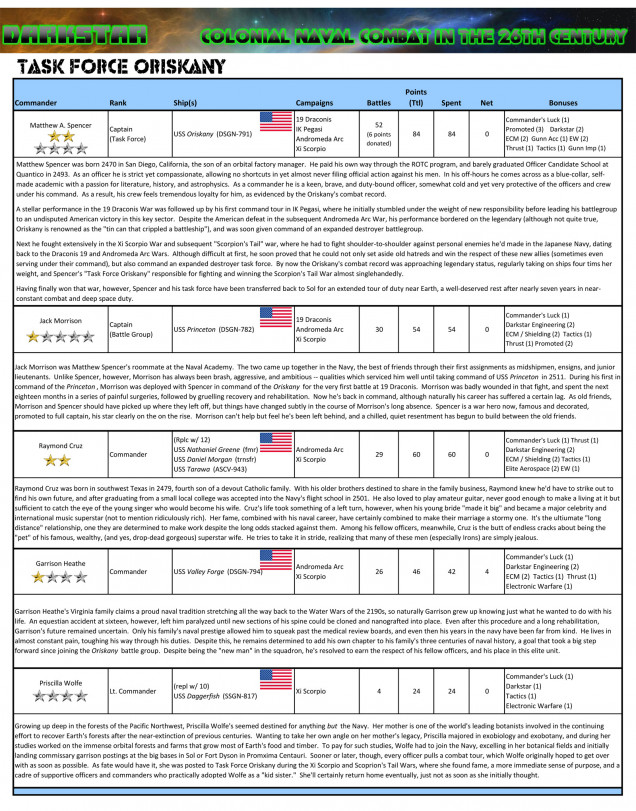
DARKSTAR CAMPAIGN UPDATE: DUCHESS ANNABEL’S WAR IS OVER
Darkstar - Sample Starship Commanders Career Tracking Sheet
Good afternoon ~
Okay, for those who might be interested, here is what one of our starship commander “career tracker” sheets look like.
Obviously, this sheet is for some of our most advanced (i.e., oldest) “characters,” who have been in plenty of wars, conflicts, battles, and campaigns, and have the experience points and upgrades to prove it.
So obviously the first thing listed is the commander’s name, followed by his rank. We use a standardized US Navy / Royal Navy navy rank system for all factions except the corporate consortium, but even their levels are all the same (just with different names).
There are also “ratings” for battlegroup commander, task force commander, and fleet commander. This represents the size of the force that commander is eligible to lead from his flagship. Battlegroups are up to 250 points, task forces to 500 points, and fleets 501+ points.
For instance, as the skipper of a destroyer, Matthew Spencer started his “career” as a Commander. His first promotion was for a Commander (Battlegroup), then Captain. Because he’d already paid for his “Battlegroup” rating, he took it with him to Captain. Then he was “promoted” again to “Captain / Task Force,” which was required when his force got so expensive (through upgrades, etc) that it became worth more than 250 points.
Hence, he’s been promoted three times.
Next is the ship he commands, obviously USS Oriskany and the US Navy pennant / registry number (DSGN-791). Notice some of these commanders have replacements and transfers. Replacements are for when a ships is destroyed and must be replaced, transfers are for when a commander willingly switches ships or is promoted to a new class of warship (e.g., destroyer to light cruiser).
This is important to track while transfers are unlimited (within reason), replacements are limited to three in a career. After you lose three ships, the Admiralty “promotes you behind a desk” where you can’t do any more damage.
Next are the wars the commander has been in, followed by the number of battles and the number of campaign points he’s earned, followed by the number of campaign points he’s spent and the upgrades he/she has bought with these campaign points.
This is system is actually quite simple. You get 1 point for taking your ship into an actual battle, win, lose, or draw. If you’re on the winning side, you get 2 points. Sometimes I give out extra points for truly large battles, kickass exploits, at the end of a war, etc.
With every 6 points, you get to buy one of the upgrades.
Note some commanders (Commander R. Cruz, for example) started with some points already in the bank. This is because, if you lose a character (death or mandatory retirement), you get to start a new commander with 1/2 however many points the former character had, and at least one rank lower. So losing a Captain with 24 campaign points (ouch!) allowed me to start a Commander with 12 points.
The stars under the character name actually tracks the upgrades the character / ship has bought. Each gold star represents five upgrades (30 campaign points, or about 20 games / battles). Silver stars are one upgrade (6 campaign points, usually about 4 battles).
Finally, underneath we have a write up we sometimes add to provide narrative for our commanders.
There are about 20 such pages between myself and all the other players who have helped play, develop, and revise Darkstar over the years.
Hope you found it interesting!































![How To Paint Moonstone’s Nanny | Goblin King Games [7 Days Early Access]](https://images.beastsofwar.com/2024/12/3CU-Gobin-King-Games-Moonstone-Shades-Nanny-coverimage-225-127.jpg)









































I like the elegance and simplicity of the mechanics. More importantly, the narrative flavour is strong, and a great example of “the stories we tell”.
Thanks, @davehawes. 😀 Yeah, we all have little “head stories” for our commanders. Not everyone writes them down, though. Written or not, however, they add so much to the flavor of the game, we really want to root for our commanders and pull for their survival and advancement.
And of course the rivalries are great! @gladesrunner ‘s Commodore Aubrey vs. @aras ‘ Captain Gold, Aubrey vs. Captain DeChalemonde, Japanese Captain H. Ozawa vs. the US Captain Matthew Spencer (commander, Task Force Oriskany above).